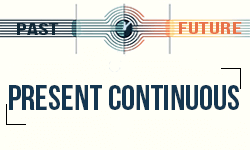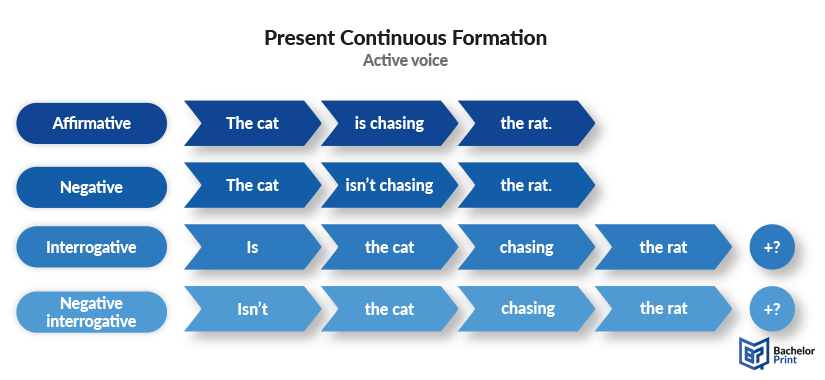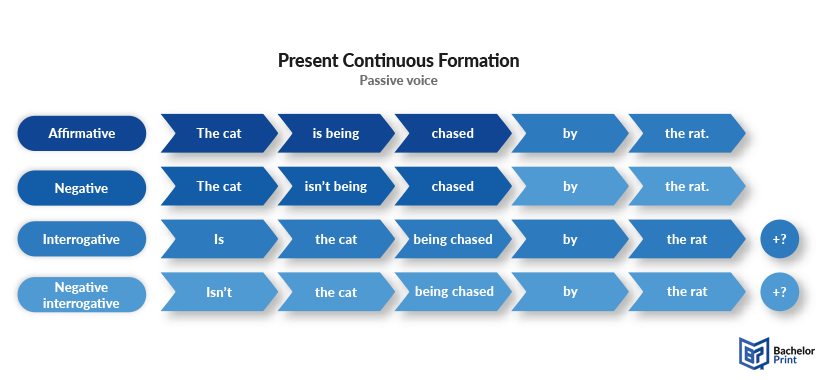
Tenses are the time machines of language rules, as they allow us to leap across moments and capture the essence of what was, what is, and what will be. Among these, the present continuous tense invites us to linger in the now, embracing the fluidity of life as it happens. In this article, we’ll explore the rules and usage of this tense through numerous examples and different exercises.
Definition: Present continuous
The present continuous tense, also known as the present progressive, is a verb tense used to describe actions that are in progress at the moment of speaking, temporary actions, official plans, or anticipated future events. With the help of auxiliary verbs and participles, present continuous conveys a sense of immediacy, movement, and change, often highlighted by specific time expressions.
Formula of present continuous active voice
Subject-verb agreement plays a considerable role when forming the present continuous tense, as it utilizes different forms of “to be” depending on the subject or pronoun. The verb form always stays the same; in the present participle (the “-ing” form of verbs), which makes its form easy to remember.
Structure
Subject + am/is/are + present participle + rest of the sentence.
Examples
Similarly to other tenses, such as the future simple tense, contractions can be used with present continuous. Below, we have created a table illustrating the shortened present continuous forms for each pronoun.
| Long version | Contraction |
| I am working. | I'm working. |
| You are working. | You're working. |
| He is working. | He's working. |
| She is working. | She's working. |
| It is working. | It's working. |
| We are working. | We're working. |
| You are working. | You're working. |
| They are working. | They're working. |
Active question form of present continuous
To form questions in the present continuous tense, we need to adjust the sentence structure by moving the helper verb “to be” to the beginning of the sentence. The verb form remains the same with active present continuous questions.
Structure
Am/Is/Are + subject + present participle + rest of the sentence?
Examples
Questions with question words
The fitting question word should precede the “to be” form of interrogative sentences with added question words in the present continuous tense.
Negative question form of present continuous
As with other tenses, such as past simple, you can use a contraction or invert the subject of an active sentence and add “not” before the verb when forming negative present continuous questions.
Structure
Am/Is/Are + subject + not + present participle + rest of the sentence?
Or
Aren’t/Isn’t/Aren’t + subject + present participle + rest of the sentence?
Examples
Note: “Am I not” is considered to be extremely formal, so using “aren’t I” is recommended unless you are writing an academic paper.
Negative questions with question words
When forming negative questions with question words (who, what, where, etc.) in present continuous, the question word is simply added in front of the sentence.
We have created an image depicting all structures for the present continuous form in active voice.

Practice worksheet
Before diving into the next sections, let’s test your understanding of the active present continuous tense with this exercise. The answers can be found in the second tab.
- She ____ a surprise party for her friend. (To organise, affirmative)
- They ____ for the exam right now. (To study, negative)
- ____ she ____ to the meeting today? (To come, negative)
- ____ you ____ that new book everyone is talking about? (To read, affirmative)
- Why ____ he ____ so late tonight? (To work, affirmative)
- We ____ a trip to the mountains next weekend. (To plan, affirmative)
- What ____ they ____ in the meeting? (To discuss, affirmative)
- He ____ his phone at the moment. (To answer, negative)
- Where ____ you ____ on your holiday this year? (To go, affirmative)
- ____ they ____ soccer in the park this afternoon? (To play, negative)
- She is organizing a surprise party for her friend. (To organise, affirmative)
- They aren’t studying for the exam right now. (To study, negative)
- Isn’t she coming to the meeting today? (To come, negative)
- Are you reading that new book everyone is talking about? (To read, affirmative)
- Why is he working so late tonight? (To work, affirmative)
- We are planning a trip to the mountains next weekend. (To plan, affirmative)
- What are they discussing in the meeting? (To discuss, affirmative)
- He is not answering his phone at the moment. (To answer, negative)
- Where are you going on your holiday this year? (To go, affirmative)
- Aren’t they playing soccer in the park this afternoon? (To play, negative)
Formula of present continuous passive voice
The present continuous passive voice is formed by using the conjugation of the verb “to be” into one of its present forms, the present participle “being,” and the past participle (3rd past form) of the main verb. If people are involved in the passive sentence, we use the “by” agent to indicate the doer of the action. The object of an active sentence then turns into the subject of the passive sentence.
Structure
Subject + am/is/are + being + past participle (+ by agent) + object.
Structure
Subject + am/is/are + not being + past participle (+ by agent) + object.
Or
Subject + aren’t/isn’t/aren’t + being + past participle (+ by agent) + object.
Structure
Am/Is/Are + subject + being + past participle (+ by agent) + object?
Structure
Am/Is/Are + subject + not + being + past participle (+ by agent) + object?
Or
Aren’t/Isn’t/Aren’t + subject + not + being + past participle (+ by agent) + object?
The illustration below depicts all structures of the present continuous tense in passive voice.

Indicators and usage of present continuous
The present continuous tense is characterized by specific time expressions that signal when an action is happening. Additionally, its usage is quite versatile, which we will further explain in the sections below.
At the present
The present progressive is often used to describe temporary events and actions that are or are not happening right now.
In progress
The tense also describes actions currently in progress, but may not necessarily be happening at the exact moment of speaking. These actions are ongoing and have not yet been completed.
In the near future
The present continuous can also be used to describe planned actions or arrangements that will definitely happen in near future events. Compared to future simple, this usage conveys a sense of certainty about future events and plans.
Repetition and annoyance
Present progressive can also express actions that are repeated frequently. However, unlike the present simple form, there are negative connotations behind the sentences. In this case, repetition itself is emphasized, often accompanied by adverbs like “always,” “constantly,” or “forever.”
Time expressions
The following time expressions are frequently used with the present continuous tense to indicate the timing of the action:
- Now
- Soon
- Right now
- At the moment
- Currently
- Tonight
- This week
- Next weekend
Note: “Now” can mean multiple things in English, such as this second, today, this year, etc. We can use the present continuous to express that we are in the process of doing a longer action, but might not be doing it in this specific moment.
- ✓ Free express delivery
- ✓ Individual embossing
- ✓ Selection of high-quality bindings
Short answers in present continuous
Short answers in present continuous follow a simple structure in the active and passive voice, as seen in the examples below.
Active voice
Structure
Affirmative: Yes, + subject + am/is/are.
Negative: No, subject + am/is/are + not.
Passive voice
Structure
Affirmative: Yes, + subject + am/is/are.
Negative: No, subject + am/is/are + not.
Present simple vs. present continuous
Both tenses are happening at the current time, what sets them apart is that present simple (in purple) is used for regular actions or facts, whereas present continuous (in orange) is specifically used for actions happening right now. Below, we have listed several example sentences, underlining each of their usages.
Possible mistakes
When it comes to the usage of present continuous, it is easy to make mistakes if you are not familiar with certain rules and exceptions. Below are some common pitfalls and how to avoid them.
Non-continuous verbs
Mixed verbs
To find out more about the different types of verbs, click on the button below to get redirected to our verbs article.
Another mistake occurs when an adverb is misplaced in a sentence. Adverbs of frequency (e.g., always, never, often) usually appear after the auxiliary verb and before the main verb in the present continuous. However, adverbs of time (e.g., now, currently) can be placed at the beginning or end of a sentence.
To learn more about adverbs, refer to our article about them by clicking on the button below.
Idioms and idiomatic expressions often don’t follow the usual grammatical rules.
The expression “I have a cold” uses the present simple tense because “have” in this context is a stative verb, which describes a state rather than an action or process.
In this case, “believe” is yet another stative verb that describes a state of mind or opinion, rather than an action. Therefore, it is correctly used in the present simple tense.
Practice exercise
The practice sentences provided below encompass diverse aspects of the present continuous tense, including both active and passive forms and interrogative and negative structures. The correct verb forms can be found on the second tab.
- Why ____ the baby ____ peacefully tonight? (To sleep, negative)
- Who ____ the meeting this afternoon? (To attend, negative)
- A surprise trip ____ by us for our parents. (To plan, passive)
- He ____ his bike in the garage. (To fix, affirmative)
- I ____ an interesting book on psychology. (To read, affirmative)
- The marketing strategy ____ in the meeting. (To discuss, passive)
- What cake ____ tonight? (To bring, passive)
- The car ____ by him. (To tow, passive)
- The recipe ____ by them. (To read, passive)
- She ____ care of the injured dog. (To take, affirmative)
- Why isn’t the baby sleeping peacefully tonight? (To sleep, negative)
- Who isn’t attending the meeting this afternoon? (To attend, negative)
- A surprise trip is being planned by us for our parents. (To plan, passive)
- He is fixing his bike in the garage. (To fix, affirmative)
- I am reading an interesting book on psychology. (To read, affirmative)
- The marketing strategy is being discussed in the meeting. (To discuss, passive)
- What cake is being brought tonight? (To bring, passive)
- The car is being towed by him. (To tow, passive)
- The recipe is being read by them. (To read, passive)
- She is taking care of the injured dog. (To take, affirmative)
FAQs
- She is reading a book.
“Is reading” indicates that the action is happening right now.
The present continuous tense describes actions that are happening right now, ongoing actions, or actions that are planned for the near future. It is formed by using the auxiliary verb “to be” (am/is/are) followed by the main verb in its “-ing” form. This tense highlights the process of the action and its relevance to the present moment.
- She is cooking dinner right now.
- They are playing soccer in the park.
- I am writing a letter to my friend.
- He is watching a movie this evening.
- We are working on a new project.
- The teacher is explaining the lesson to the students.
- The dog is barking at the mailman.
- The children are drawing pictures in class.
- The bus is arriving at the station now.
- The company is launching a new product next week.
The rule for the present continuous tense is to use the appropriate form of the verb “to be” (am, is, are) based on the subject, followed by the base verb with an “-ing” ending.
Examples
- He is riding the bike.
- They are coming to the party.
